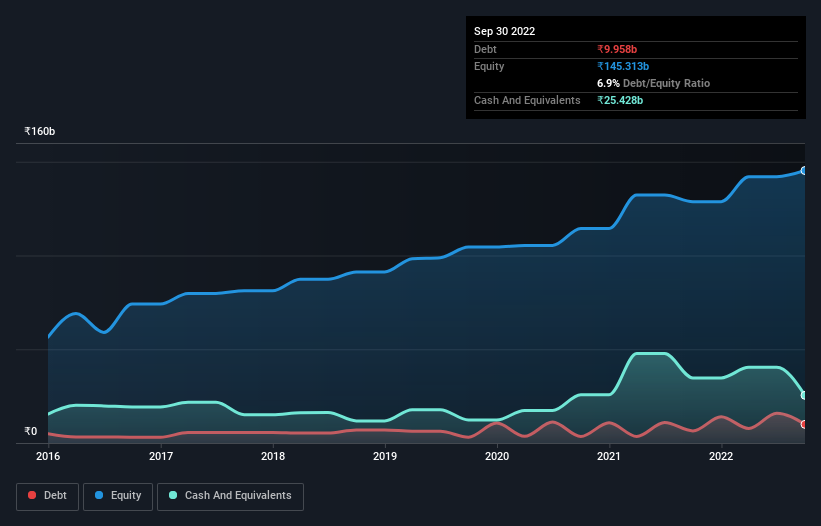These 4 Measures Indicate That Asian Paints (NSE:ASIANPAINT) Is Using Debt Reasonably Well

David Iben put it well when he said, 'Volatility is not a risk we care about. What we care about is avoiding the permanent loss of capital.' So it seems the smart money knows that debt - which is usually involved in bankruptcies - is a very important factor, when you assess how risky a company is. Importantly, Asian Paints Limited (NSE:ASIANPAINT) does carry debt. But the real question is whether this debt is making the company risky.
What Risk Does Debt Bring?
Debt assists a business until the business has trouble paying it off, either with new capital or with free cash flow. Ultimately, if the company can't fulfill its legal obligations to repay debt, shareholders could walk away with nothing. However, a more frequent (but still costly) occurrence is where a company must issue shares at bargain-basement prices, permanently diluting shareholders, just to shore up its balance sheet. Of course, plenty of companies use debt to fund growth, without any negative consequences. The first step when considering a company's debt levels is to consider its cash and debt together.
Check out our latest analysis for Asian Paints
What Is Asian Paints's Net Debt?
As you can see below, at the end of September 2022, Asian Paints had ₹9.96b of debt, up from ₹6.44b a year ago. Click the image for more detail. But on the other hand it also has ₹25.4b in cash, leading to a ₹15.5b net cash position.

How Healthy Is Asian Paints' Balance Sheet?
The latest balance sheet data shows that Asian Paints had liabilities of ₹84.2b due within a year, and liabilities of ₹12.9b falling due after that. On the other hand, it had cash of ₹25.4b and ₹40.7b worth of receivables due within a year. So its liabilities outweigh the sum of its cash and (near-term) receivables by ₹30.9b.
This state of affairs indicates that Asian Paints' balance sheet looks quite solid, as its total liabilities are just about equal to its liquid assets. So while it's hard to imagine that the ₹2.92t company is struggling for cash, we still think it's worth monitoring its balance sheet. Despite its noteworthy liabilities, Asian Paints boasts net cash, so it's fair to say it does not have a heavy debt load!
And we also note warmly that Asian Paints grew its EBIT by 20% last year, making its debt load easier to handle. There's no doubt that we learn most about debt from the balance sheet. But ultimately the future profitability of the business will decide if Asian Paints can strengthen its balance sheet over time. So if you're focused on the future you can check out this free report showing analyst profit forecasts.
Finally, while the tax-man may adore accounting profits, lenders only accept cold hard cash. Asian Paints may have net cash on the balance sheet, but it is still interesting to look at how well the business converts its earnings before interest and tax (EBIT) to free cash flow, because that will influence both its need for, and its capacity to manage debt. Looking at the most recent three years, Asian Paints recorded free cash flow of 49% of its EBIT, which is weaker than we'd expect. That weak cash conversion makes it more difficult to handle indebtedness.
Summing Up
We could understand if investors are concerned about Asian Paints's liabilities, but we can be reassured by the fact it has has net cash of ₹15.5b. And we liked the look of last year's 20% year-on-year EBIT growth. So we don't think Asian Paints's use of debt is risky. Over time, share prices tend to follow earnings per share, so if you're interested in Asian Paints, you may well want to click here to check an interactive graph of its earnings per share history.
If you're interested in investing in businesses that can grow profits without the burden of debt, then check out this free list of growing businesses that have net cash on the balance sheet.
New: Manage All Your Stock Portfolios in One Place
We've created the ultimate portfolio companion for stock investors, and it's free.
• Connect an unlimited number of Portfolios and see your total in one currency
• Be alerted to new Warning Signs or Risks via email or mobile
• Track the Fair Value of your stocks
Have feedback on this article? Concerned about the content? Get in touch with us directly. Alternatively, email editorial-team (at) simplywallst.com.
This article by Simply Wall St is general in nature. We provide commentary based on historical data and analyst forecasts only using an unbiased methodology and our articles are not intended to be financial advice. It does not constitute a recommendation to buy or sell any stock, and does not take account of your objectives, or your financial situation. We aim to bring you long-term focused analysis driven by fundamental data. Note that our analysis may not factor in the latest price-sensitive company announcements or qualitative material. Simply Wall St has no position in any stocks mentioned.
About NSEI:ASIANPAINT
Asian Paints
Engages in the manufacturing, selling, and distribution of paints, coatings, and products related to home decoration and bath fittings in Asia, the Middle East, Africa, and the South Pacific region.
Excellent balance sheet established dividend payer.


